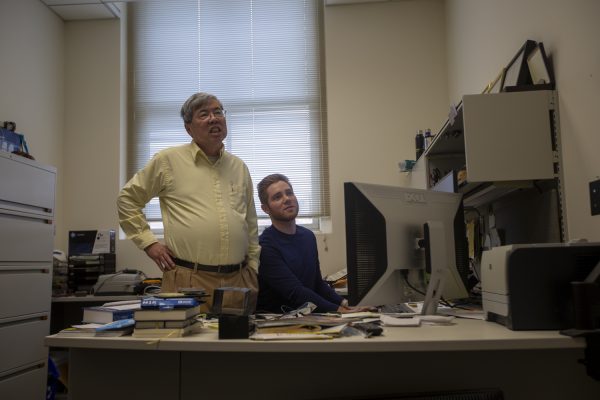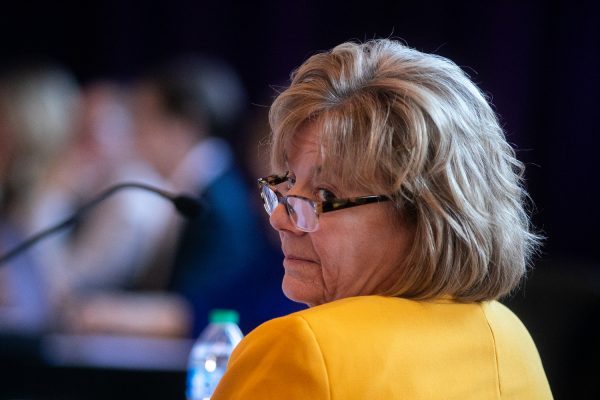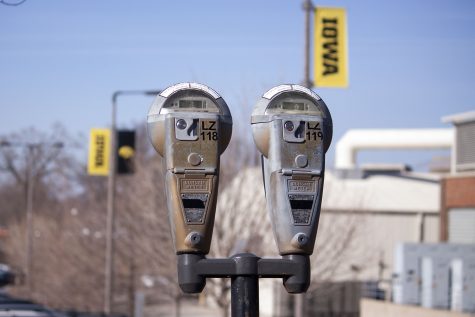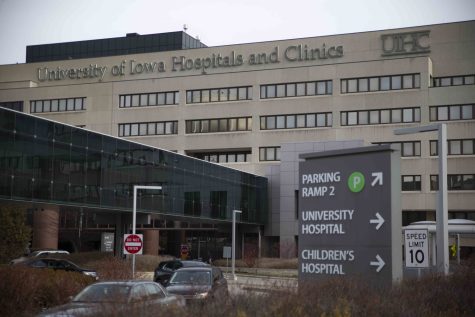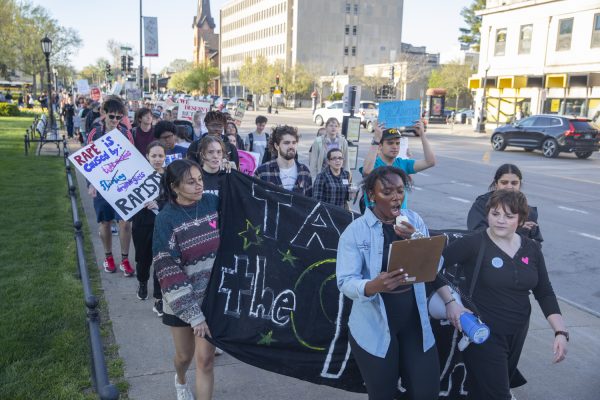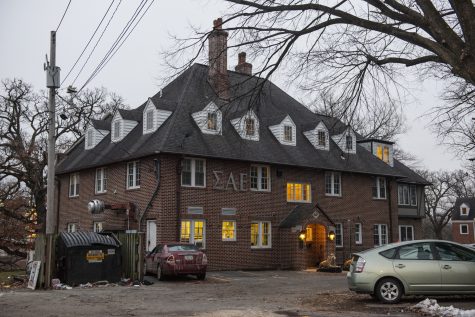A year ago, the University of Iowa shut down campus. Now, it’s navigating a new financial future
The University of Iowa lost millions to the COVID-19 pandemic, as it prepares for a national decline in enrollment. But administrators say the UI looks to bounce back as cases are subsiding.
The Old Capitol building is seen on March, 6, 2021.
March 17, 2021
University of Iowa freshman Sarah Grace Hovey was living on campus in fall 2020 until University Housing and Dining sent a campus-wide email offering refunds for housing contracts because of COVID-19. Taking the refund, Hovey said moving home was a financial benefit and quelled her anxieties about contracting COVID-19.
Hovey is among many students who have reconsidered financial decisions because of the pandemic. The university is preparing for a steady decrease in enrollment as it continues to reconcile the ongoing financial effects of the coronavirus.
Nevertheless, UI administrators say the university has made progress, almost a year since the first self-reported student case of COVID-19 was recorded on March 19, 2020. As of March 5 this year, six students self-reported having tested positive for the virus.
As previously reported by The Daily Iowan, cases trended higher when students returned to campus at the start of the fall 2020 semester, with 1,569 positive cases recorded by Sept. 7, 2020. Data from Johnson County shows the gradual decrease in COVID-19 cases since then, with a recent positivity rate of nearly 3 percent on March 11, compared to nearly 60 percent in August 2020.
“The good thing is the progress that’s being made,” UI Senior Vice President for Finance and Operations Rod Lehnertz said. “And having a world class health care system on our campus helps us to be at the front edge of both innovation and advancement on this.”
‘A silent World War’ for resources
When the pandemic initially came to Iowa in March 2020, the UI wanted to “do the right thing,” and worry about funding any expenses later, Lehnertz said.
He added that the UI had learned from the 2008 flood to take careful, complete records of everything in a crisis, including any costs it amassed. In the summer of 2008, Iowa City was hit with a 500-year-flood that damaged 20 campus buildings and cost the UI around $700 million in repairs.
In a crisis like the pandemic, he said, the university’s initial costs involved a worldwide chase for masks, gowns, and sanitizers.
According to a report from the U.S. Organization for Economic Cooperation and Development, the world was facing an impending shortage of face masks by May 2020, when they were slated to increase a possible 10 times more in demand than they had been before the pandemic in countries affected by COVID-19.
RELATED: ‘We have to keep people safe’: Hawkeyes at the heart of University of Iowa’s COVID-19 response
“And we were hearing from sources that it was almost like a silent World War — every country in the world was going after the supplies,” Lehnertz said.
Students began moving out of the residence halls in March 2020, and University Housing and Dining refunded around $16 million to students who left campus for home, according to a UI financial report. This made it a challenge for the UI to cover existing debt from two campus residence halls, Lehnertz said.
Undergraduate Student Government Director of Finance Emily Hagedorn was studying abroad when the pandemic began. When the USG executive cabinet and senate came into their positions in April 2020, none of them expected the year that would come, Hagedorn said.
“So, we really had to look at the student experience and what they need and how we can best support that,” she said. “There’s always a way, you know, we always find a way to help, in order to do our jobs in what is probably the most unique year in our history.”
When USG initially realized in spring 2020 it wouldn’t have as many events to fund because of COVID-19, she said, the organization redirected many of its student fee dollars into the Dean of Students’ Student Life Emergency Fund, which the organization traditionally supported.
According to a report from the Division of Student Life, the student-emergency fund supports UI students who are facing financial emergencies or catastrophic events that would otherwise cause them to suspend their education at the university.
When she assumed her role by April 2020, Hagedorn said USG continued to funnel money into the emergency fund with rollover funds that would otherwise go unspent.
By June 2020, the state Board of Regents had announced a tuition freeze for students because of financial uncertainty caused by the pandemic. Lehnertz said tuition revenue and state appropriations provide the bulk of the UI’s general fund, so the tuition freeze took a chunk out of the UI’s revenue projections, and how the university pays faculty and for student programs.
The UI and the regents wanted to do the right thing in a tough time, however, and avoid increasing tuition to levels that would have been overly burdensome to students, Lehnertz said.
“No one comes to expect that you’re going to face something like we faced in COVID-19,” Lehnertz said.
The UI encountered additional costs as it prepared for students to return to campus in fall 2020. This included switching out the UI’s air filtration systems to HVAC systems known as MERV13. While the change was expensive, Lehnertz said, it offers a higher degree of protection against the coronavirus.
The UI Critical Incident Management Team, composed of various campus leaders, convened in March to respond to the pandemic and has managed the university’s response ever since.
Timeline by Natalie Dunlap/The Daily Iowan
UI Campus Health Officer Dan Fick said in March and April 2020, campus leaders were just trying to figure out “what in the world was happening,” and searching for information to help.
Fick, who was interim head of the Department of Family Medicine at the time, said COVID-19 added to existing academic and clinical duties on campus, making for a very busy spring and summer in 2020. He frequently stayed up working until midnight only to wake up at 5 a.m. to get some exercise and start his day again.
UI Executive Vice President and Provost Kevin Kregel, who was executive vice provost and senior associate provost for faculty before assuming his current role on an interim basis this summer, said the university was somewhat prepared for a crisis like the pandemic because of its experience in the 2008 flood.
Many of the leaders on the Critical Incident Management Team also led during the flood, Kregel said, and that experience equipped them to respond to COVID-19 in a way that many other universities weren’t prepared for.
“I think our structure and the people we had on the team really allowed us to go through it in a real rigorous, conscientious way and make the right decisions for campus,” Kregel said. “And we didn’t have to walk anything back.”
What’s the cost of COVID-19 really?
The state Board of Regents’ financial losses from COVID-19 exceed an estimated $185 million — and after rounds of federal funding the UI’s estimated loses amount to $83.4 million, according to documents provided by the UI.
Lehnertz said, between the UI’s general fund, which primarily takes care of campus, and its auxiliaries, the supportive units that make campus what it is, the auxiliaries were hit hardest by COVID-19. This includes UI Athletics, Housing and Dining, and other divisions of campus.
Data visualization by Eleanor Hildebrandt/The Daily Iowan
The UI’s largest individual expense from COVID-19 amounted to an estimated $50-60 million loss in UI Athletics. To mitigate costs, the department announced that men’s tennis, men’s gymnastics, and men’s swimming and diving will be cut after their current season.
Lehnertz said the athletics department will borrow roughly that same amount from the university to make up for these losses, because state law prohibits it from borrowing elsewhere — putting more financial pressure on the UI.
The athletics department will pay the UI back for the money it borrows over a decade, Lehnertz said, adding a $5 million burden to the athletic department each year. It’s instances like these, he said, where funding from the federal CARES Act or the Higher Education Emergency Relief Fund become incredibly important to the university.
“We won’t recover from the costs that happened because of COVID-19 overnight,” Lehnertz said.
RELATED: Financial losses for Iowa regent universities due to COVID-19 exceed $185 million
Comparatively, Iowa State University lost an estimated $90.2 million from overall COVID-19 impact and state reductions, according to documents provided to the DI. The University of Northern Iowa lost an estimated net of $12.03 million because of COVID-19 and fewer state allocations since last year.
Another expense on the UI campus has been COVID-19 testing, Fick said. Testing is now becoming cheaper, however, because the UI filters COVID-19 tests through the State Hygienic Laboratory at UI Hospitals and Clinics, he said.
“The advantage we have is we’ve got our experts here on campus,” Fick said. “We have a phenomenal College of Public Health with a tremendous amount of experience.”
Unlike some of its peer institutions, including ISU, the UI did not mandate COVID-19 testing for students upon their return to campus in fall 2020.
Fick said this was partly because there’s little evidence that mandatory testing made a difference within the couple of weeks that students returned to campus, and partly because it’s expensive. Universities were purchasing them for $100 a test, he said.
Hagedorn said there were enough leftover USG funds because of a decrease in student activity that USG contributed an additional $10,000 to the student-emergency fund by the end of the fall semester, specifically for COVID-19 test reimbursement. The organization also donated money to the food pantry and clothing closet, Hagedorn said, to help students meet their basic needs.
“I work with fellow students,” Hagedorn said. “We talk to administrators, but at the end of the day, I’m using student dollars. We’re all voting on student dollars to go back to the students and we have to figure out what’s going to help them the most. It’s an equity thing — we all pay into it, we should all be able to see worth out of it.”
The financial impact of COVID-19 is compounded by a decrease in state appropriations, which the Iowa Legislature cut by $8 million in June 2020. This, plus the regents’ decision to freeze tuition rates, meant the regents’ general university operating budgets for fiscal 2021 are $65.4 million less than fiscal 2020.
A decline in state funding was a primary motivator of the university’s public/private partnership, an agreement for a private company to operate its utilities finalized in December 2019 that allows the UI to benefit financially from its utility system.
When asked whether the UI would consider additional public/private partnerships in other parts of campus, Kregel told the DI it remains a valid option for alternative revenue at the university, particularly in light of decreased state funding.
On March 12, the regents approved a private partnership between the UI and Follett Higher Education Group, which allows the company to take over operations of the Iowa Hawk Shop’s online and retail sales.
He said the current utility public/private partnership will fund the university’s next strategic plan, which puts the UI in a unique position because universities traditionally struggle to find funding to support strategic initiatives.
The UI extended the timeline for its five-year strategic plan to allow time to evaluate the impact of COVID-19, according to its website. Kregel said the theme for the UI’s new strategic plan, which is slated to start in July 2022, is to build the UI up as a destination university, and hopefully bring more students to the UI.
“And so, what that means, in my mind, is to identify those really strong programs on campus — what makes the University of Iowa unique — to attract students in a variety of settings,” Kregel said.
Enrollment steadily approaches drop-off
The UI’s plan to advertise itself as a destination university deals with an impending issue for college campuses nationwide that is now compounded by the pandemic — a steady decrease in enrollment. Data from the National Student Clearinghouse Research Center shows a 4.4 percent decline in college enrollment nationally. In Iowa, a 7.1 percent decline in higher education enrollment was reported.
Kregel said the UI is evaluating how to address this sharp drop-off in enrollment by looking at opportunities to recruit more non-resident students and engage more with in-state students.
“Like every other university in terms of enrollment numbers, it’s going to be a challenge for us,” Kregel said.
According to the regents’ fall enrollment report, the UI reported a 2.5 percent drop in overall enrollment in fall 2020. Regents’ institutions reported a total enrollment decrease of 4.4 percent across its institutions, which amounts to a loss of 3,333 students.
Data visualization by Natalie Dunlap/The Daily Iowan
Following declining enrollment, gap-year applications at the UI increased in fall 2020. Kregel said the UI is aware of the number of students who have opted to take a gap year because of the pandemic, and has engaged with them to provide opportunities for their return to campus in the fall.
Kregel said application numbers for 2021 are looking strong, however, in spite of projections for a major decline in enrollment because of the pandemic.
Hovey, who took her classes online from home this semester, said she will return to campus in fall 2021 when learning will be mostly “hands-on” and in person.
“The resiliency of our campus has been and continues to be amazing to me,” Kregel said. “Faculty, staff, and students all really trying to work through some really difficult challenges, and, for the most part, maintaining a real positive attitude. I think we really weathered the storm and had a pretty successful outcome.”
USG, which is funded by the student-activity fee, is facing a $42,000 deficit to cover its costs because of decreased student enrollment, Hagedorn said. The student-activity fee funds USG, student services, Graduate and Professional Student Government, and student organizations. Due to decreased programming during COVID-19, however, she said there has fortunately been very little issues for USG making its payments.
In addition to decreasing enrollment, Lehnertz voiced concern for the need for retention of already-enrolled students which greatly impacts tuition revenue. Investments from the public/private partnership into student success will hopefully ramp up retention rates, Lehnertz said, as well as other campus engagement efforts.
“We want to develop pride not only in the University of Iowa, but in higher education and what it means for the state,” Lehnertz said. “And so, retention matters not just for the dollar, but for the trajectory of every one of those students.”
As one of many UI students planning to return to campus next year, Hovey said being at the UI will feel different with mostly in-person classes. She said she is excited to experience what she missed out on this year.
“In-person classes are something that I am really nervous for because this whole year has been online for me,” Hovey said. “I feel like I missed out on my freshman year of college, but I made the right decision to move home.”
Editor’s note: This article has been updated to reflect that the state Board of Regents’ three universities collectively lost $185 million because of the pandemic, not the University of Iowa alone. The UI lost an estimated $83.4 million in revenue. The DI regrets the error.








